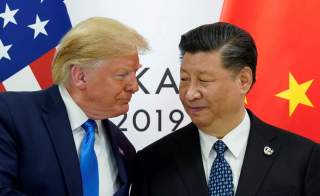Trade Truce? China and America Have a Small Trade Deal—but Will It Last?
What if it falls apart?
The United States and China moved Dec. 12 to soothe the sting of their trade war, agreeing in principle to a so-called "phase one" trade deal that would ease the reciprocal tariffs that have reverberated through the world economy for almost two years. One crucial aspect of the deal is an agreement by the United States to suspend additional tariffs set to take effect Dec. 15 and, crucially, reduce some of the tariffs already in place on some $360 billion in Chinese goods. And thanks to the deal, Washington and Beijing might finally have exited their tit-for-tat tariff escalations, although clouds remain on the horizon: After all, the scope of the phase one deal is narrow, and the two sides will struggle to agree to a more comprehensive deal — portending perhaps even more disruptive battles in the tech supply chain in the year to come.
What's in the Deal
Although officials did not provide text of the agreement that was authorized by U.S. President Donald Trump, Washington has reportedly agreed to cancel a new round of 15 percent tariffs on $160 billion worth of Chinese products — mainly consumer goods. According to leaks of the deal's details, the United States will also cut existing tariffs of 25 percent on $250 billion in Chinese products to 12.5 percent and of 15 percent on another $112 billion in goods to 7.5 percent. In return, China has reportedly made an oral agreement to purchase $50 billion in U.S. agricultural products in 2020. Plus, China promised to broaden access to its financial sector and better protect U.S. intellectual property rights. The sides could sign an outline of the deal as early as Dec. 13.
The agreement stands to immediately limit the collateral damage to U.S. importers, who have borne significant costs from the tariffs, and U.S. consumers facing the prospect of much higher prices for consumer goods like mobile phones, laptops, toys and clothing. If finalized, the agreement also would aid the Chinese economy, which is growing at its slowest pace in nearly three decades, giving Beijing more breathing room to address some of its economy's structural risks.
And there's good news for the global economy, too, as the deal could spur growth by as much as 0.5 percent in 2020. In terms of third countries, the trade deal would give a significant reprieve to key Asian exporters like Singapore, South Korea and Japan, which have experienced major supply chain disruptions and found themselves caught in the crossfire of tariff salvos. But the possible significant increase in U.S. farm purchases could also limit Chinese demand from other suppliers, especially for soybeans from Brazil and Argentina.
What to Watch For
But now that Washington and Beijing have apparently struck their deal, there are two key points to watch. First, not all the details have been spelled out, meaning clashes over the final wording could yet erupt. The deal's scope regarding intellectual property rights, for instance, will depend on the exact language of the final agreement, and any differences over the farm purchase promise could raise further questions.
Second, there is little guarantee that the United States and China will take a similar view on implementing and interpreting the deal — even on the sections that both have already signed off on. In past negotiations, they have differed on the sequencing, timing and details of other deals. Such differences of opinion will almost certainly occur with the phase one deal as well, especially on issues like the contract structures for China to buy U.S. goods, when those purchases will occur, and so forth. Further complicating the picture is a disagreement over human rights issues, which has loomed large over the talks. Given that, it is entirely possible that some of these issues could scuttle this limited deal before the sides manage to hammer out a more wide-ranging agreement.
Still, if the limited deal endures, it could rescue the countries' trade talks from endless cycles of tariff escalation and de-escalation that have marred their dialogue in 2018 and 2019. As it is, however, Washington and Beijing are unlikely to seal a more comprehensive deal in 2020 as they have yet to even begin discussing the elephants in the room, such as Chinese industrial policy and Bejing's subsidies to state-owned sectors. What's more, even as the White House phases out tariff options, the bipartisan consensus to curb China's technological capabilities ensures it is all but certain that the United States will continue to oppose Chinese tech firms — irrespective of any trade deal or who the president is.
Finally, the bargain with China, as well as progress this week on the United States-Mexico-Canada Agreement (USMCA), illustrates Trump's desire to prove his bona fides as a dealmaker ahead of U.S. presidential elections next year. In both cases, the White House made significant concessions on some of its key initial demands to close the deal. On the USMCA, congressional Democrats were able to get much of what they had demanded during the ratification process; in the phase one deal, China floated many of the same concessions it had offered in failed 2017 negotiations. Given Trump's desire for deals, then, he could well rush ahead to end other pressing international disputes in 2020 — such as those with North Korea and Iran. But even if Trump is pushing for photo-friendly deals ahead of the presidential elections, Washington and Beijing remain too far apart on structural issues to move an expanded deal forward anytime soon.
A Narrow Deal Calms the U.S.-China Trade War, For Now is republished with the permission of Stratfor Worldview, a geopolitical intelligence and advisory firm.
Image: Reuters.

